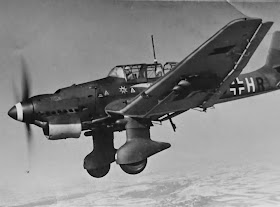Junkers
Ju 87 B-1 Stuka
El Junkers Ju 87 B Stuka
(Sturzkampfflugzeug, o bombardero en picado) constituyó la primera serie de
este legendario bombardero en picado en ser producido en masa. Antes de
comenzar con su producción se construyeron 6 prototipos denominados Ju 87 B-0
comenzando sus pruebas de vuelo en el verano de 1937 y posteriormente servirían
como base para las versiones navales Ju 87 C y E.
El primer modelo de producción
fue el Ju 87 B-1 que estaba equipado con un motor Junkers Jumo 211D de 1.184 hp
de potencia. Este modelo introdujo un fuselaje y el tren de aterrizaje
rediseñados. Los primeros aparatos en salir de la cadena de montaje fueron
enviados a España para pruebas operativas dónde demostraron su eficacia como
artillería volante. Tras estos éxitos iniciales la producción se incrementó
hasta alcanzar los 60 aparatos al mes. Este aumento en la producción
proporcionó 336 Junkers Ju 87 B-1 a las unidades de la Luftwaffe cuando estalló
la Segunda Guerra Mundial. Estos aparatos estaban equipados con las famosas
“Trompetas de Jericó”, unas sirenas instaladas en el borde de ataque de las alas,
delante del tren de aterrizaje, o en el borde delantero del carenado principal.
Estas sirenas, de 0´7 m de diámetro, eran accionadas por unas hélices y
provocaban un aterrador sonido durante el picado que causaba el intimidación y
pánico en las tropas enemigas. A lo largo de la contienda este efecto
desapareció y las sirenas fueron retiradas ya que, además, provocaban la
pérdida de entre 20 y 25 Km/h la velocidad punta debido a la resistencia de las
mismas. La utilización del ruido en tal sentido continuó ya que algunas bombas
eran equipadas con un silbato en la aleta que producía un ruido similar al ser
lanzadas.
La producción del Ju 87 B-1
comenzó en julio de 1937; 89 fueron construidos en la fábrica de Junkers en
Dessau junto con otros 40 más completados en Weserflug de Lemwerder. De esta
última factoría se transfirió la producción a partir de abril de 1938, pero la
producción del Ju 87 B-1 continuó hasta marzo de 1940. En total se completaron
697 Ju 87 B-1 (de ellos 311 fabricados por Junkers y 389 por
Weserflug). El último de los Ju 87 B en salir de las
cadenas de montaje lo hizo en octubre de 1940.
Fuentes:
MURAWSKI, M. J., “Junkers Ju
87, vol. I, II y III” Kagero, Monografie.
ERFURTH, H. “Junkers Ju 87 black cross”.
GRIEHL, M. “Junkers Ju 87 Stuka”. Airlife Publishing/Motorbuch, 2001
English version
The Junkers Ju 87 B Stuka (Sturzkampfflugzeug or dive bomber) was the
first installment of this legendary
dive bomber to be mass produced. Before beginning production in June prototypes
called Ju 87 B-0
were built starting its flight testing in
the summer of 1937 and then
serve as a base for naval versions Ju 87 C
and E.
The first production model was the Ju 87 B-1 was equipped with Junkers Jumo 211D engine of 1,184 hp. This model introduced a fuselage and landing gear redesigned. The first devices to come out of the assembly were sent to Spain for operational tests where they demonstrated their effectiveness as flying artillery. After these initial successes the production was increased to 60 devices per month. This increased production provided 336 Junkers Ju 87 B-1 units of the Luftwaffe at the outbreak of World War II. These devices were equipped with the famous "Trumpets of Jericho" sirens installed in the leading edge of the wings, landing gear front, or leading edge of the main enclosure. These mermaids, 0.7 m in diameter, were driven by a propeller and caused a terrifying sound during chopping the intimidation and causing panic in the enemy troops. Throughout this effect disappeared contention and sirens were removed and which also caused the loss of between 20 and 25 km/h the tip speed due to the strength thereof. The use of noise in this direction continued as some bombs were fitted with a whistle flap producing a noise similar to be released.
Production of the Ju 87 B-1 began in July 1937; 89 were built in the Junkers factory in Dessau with 40 more completed in Weserflug Lemwerder. This latest production factory from April 1938 was transferred, but production of the Ju 87 B-1 continued until March 1940. A total of 697 completed Ju 87 B-1 (of which 311 and 389 manufactured by Junkers Weserflug). The last of the Ju 87 B to leave the assembly lines did in October 1940.
Sources:
MURAWSKI, M. J., “Junkers Ju 87, vol. I,
II y III” Kagero, Monografie.
ERFURTH, H. “Junkers Ju 87 black cross”.
GRIEHL, M. “Junkers Ju 87 Stuka”. Airlife Publishing/Motorbuch, 2001

















